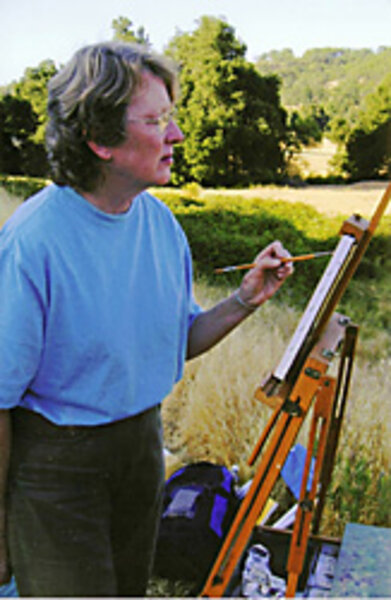Tools for an outdoor artist – brushes and a sense of humor
Loading...
Several years ago, I was researching some of the early California plein-air painters. They would head east out of San Diego in their old trucks full of camping gear and canvases and spend days on location capturing the oaks and grasslands, the isolated farms, and the desert light. It sounded so romantic until I read about how some painters, during the Depression, traded paintings now worth thousands of dollars for eggs and rent.
As an outdoor painter myself, I thought it would be wonderful to find their spots and paint there, also. So I searched for their old locations. A few places were easy to find because the titles of the paintings named recognizable features such as mountains or towns. But most were too vague to identify; "Valley Farm View" was almost surely transformed by now. This doesn't surprise me, of course. Time takes away barns, fires sweep over mountains, ponds are claimed by grasslands.
In the 14 years I've been painting, some of my early painting locations are now very different. "My" trees that had their portrait painted all those years ago have grown up, lost limbs, or had babies.
What if someone wanted to know where I painted? An easy solution came to me one day. I bought a Global Positioning System (GPS) device and began noting the precise location on the back of my paintings.
My typical painting day begins early. Because the light becomes flat as early as 9 a.m., I try to be on location by 7 a.m. I turn on my GPS device while I set up my watercolors or oils. In less than a minute, three or more satellites are located and I have latitude and longitude readings.
On an index card, I make a quick thumbnail pencil sketch to establish the composition and the darks and lights of the painting. Then I'm ready to paint. Knowing that the shadows shrink as the sun gets higher, I prefer to work in watercolors when on location. I complete them faster than oil paintings.
I'll paint again in the late afternoon when the shadows are long. I can get one or two more watercolors completed or a small oil painting before the sun goes down. Often I use the watercolor sketches to paint large oil paintings in my studio.
It helps to have a sense of humor when painting outdoors. Easels blow over in the wind, ants bite ankles, and a perfectly sunny day is interrupted by a deluge. Years ago, I once forgot to bring my canvases. (I have a checklist now – remembering to check it is another problem.)
One time I took my completed oil painting off the easel to show a friend across the field and dropped it facedown in the dirt. Another time I was halfway through a painting in a county park when an employee came along and cut down my foreground. I've even heard of a rattlesnake racing between the feet of a painter and an instructor nearly falling over a cliff as he backed away from his easel.
When things are going right, most painters will get into a "zone" where time slips by effortlessly. It's one of the joys of the profession to lose yourself in your work.
But painting on location requires extra concentration. There are all sorts of unexpected distractions.
One spring, I set up in a picnic area in the Cuyamaca Mountains near San Diego and watched a dozen woodpeckers noisily competing for territory. They would fly at one another, meet, and battle all the way to the ground. Last summer, I painted in a Nature Conservancy preserve near Santa Ysabel, Calif., with cattle munching close by. While I kept one eye on them, I could hear a cow giving birth not far off.
Painting near a road has obvious distractions; some people actually honk. But most of the time things click, and that zone steals over me.
This happened on a recent painting trip. Outside the old gold-mining town of Julian, Calif., is a locally famous feature, Volcan Mountain. One morning I painted in the shadow of that mountain. Wild turkeys were feeding behind me, and a coyote loped across my painting field in the distance. I watched as the sun lit up a grassy slope, and the trees cast long shadows. If a car drove by, I wasn't aware of it.






